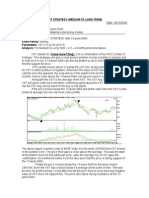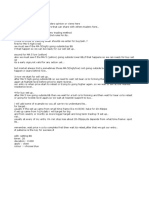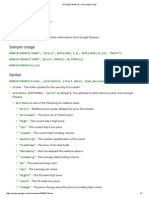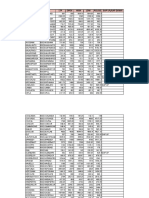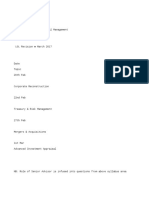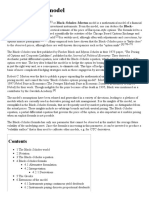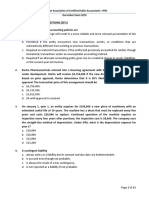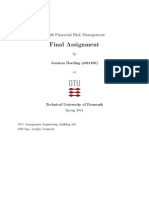Complete Notes on Option Trading and Strategies
Part 1: Core Concepts in Options Trading
1. What is an Option?
An option is a financial derivative that gives the buyer the right, but not the obligation, to buy (Call option)
or sell (Put option) an underlying asset at a predetermined price (Strike price) before or at the expiry date.
Sellers (writers) of options are obligated to fulfill the contract if the buyer chooses to exercise the option.
Options are of two types: - Call Option: Right to buy the underlying asset - Put Option: Right to sell the
underlying asset
2. Key Terminologies
a) Strike Price
The price at which the underlying asset can be bought or sold when exercising the option.
b) Spot Price (Market Price)
The current price of the underlying asset in the market.
c) Premium
The cost of purchasing the option, paid by the buyer to the seller.
d) Expiry Date
The date on which the option contract expires.
e) Open Interest (OI)
The total number of outstanding option contracts in the market. High OI indicates greater liquidity.
f) Put-Call Ratio (PCR)
PCR = Total Put OI / Total Call OI - PCR > 1 implies bearish sentiment - PCR < 1 implies bullish sentiment
g) Volatility Index (VIX)
India VIX measures market expectation of volatility over the near term. Higher VIX implies higher expected
volatility.
1
�h) Intrinsic Value and Time Value
• Intrinsic Value = Positive difference between spot and strike (for ITM options)
• Time Value = Option Premium - Intrinsic Value
i) Moneyness of Options
Defines the relationship between the spot price and strike price: - In-the-Money (ITM): Option has intrinsic
value - Call: Spot > Strike - Put: Strike > Spot - At-the-Money (ATM): Spot = Strike - Out-of-the-Money
(OTM): Option has no intrinsic value - Call: Strike > Spot - Put: Spot > Strike
Why Moneyness Matters: - Determines option premium pricing - Impacts risk-reward ratio - Influences
probability of profit - Impacts option Greeks (especially Delta and Theta)
j) Option Greeks (Intro)
• Delta: Sensitivity of option price to change in underlying
• Theta: Time decay of option price
• Vega: Sensitivity to volatility
• Gamma: Rate of change of Delta
Part 2: Detailed Strategies
1. Protective Put
Objective: Protect downside risk while holding a long position in the underlying asset.
Structure: Buy Stock + Buy Put Option
Use Case: Investors expecting bullish performance but want to hedge against possible losses.
Example: - Buy INDUSIND at ₹984 - Buy 980 Put at ₹28.3 - If price falls to ₹900 - Unhedged P/L = ₹900 -
₹984 = -₹84 - Hedged P/L = (₹900 - ₹984) + (₹980 - ₹900 - ₹28.3) = -₹32.3
Advantages: - Downside is protected - Unlimited upside potential
Disadvantages: - Cost of premium reduces net profit
2. Covered Call
Objective: Generate income from a long holding by writing a call option
Structure: Buy Stock + Sell Call Option
Use Case: Mildly bullish to neutral view
2
�Example: - Buy BANK NIFTY at 48,114 - Sell 48,200 Call Option at ₹228 - If price closes at 48,114: -
Unhedged P/L = 0 - Hedged P/L = ₹228 (Call premium) - If price closes at 48,400: - Profit on Stock = ₹286 -
Loss on Option = -₹200 - Net = ₹86
Advantages: - Income from premium - Minor downside cushion
Disadvantages: - Upside potential is capped
3. Long Straddle
Objective: Profit from significant movement in either direction
Structure: Buy ATM Call + Buy ATM Put
Use Case: High volatility expected, but direction unknown
Example: - Buy NIFTY 22400 Call at ₹150 - Buy NIFTY 22400 Put at ₹140 - Net Premium = ₹290 - If NIFTY
moves to 22800 - Call ITM: ₹400, Put OTM: 0 - P/L = ₹400 - ₹290 = ₹110
Advantages: - High profit if volatility is realized - Directional neutrality
Disadvantages: - High cost - Loss if market remains flat
4. Long Strangle
Objective: Profit from sharp moves with lower cost than straddle
Structure: Buy OTM Call + Buy OTM Put
Use Case: Volatility expected, but not enough premium to justify straddle
Example: - Buy RELIANCE 1420 Call at ₹20 - Buy RELIANCE 1380 Put at ₹22 - Net Cost = ₹42 - If price moves
to ₹1460 - Call ITM = ₹40, Put = 0 - P/L = ₹40 - ₹42 = -₹2 (break-even almost)
Advantages: - Cheaper than straddle - Lower breakeven points on both sides
Disadvantages: - Requires more movement than straddle to be profitable
Part 3: Other Strategies (Brief Overview)
1. Bull Call Spread
• Buy ATM Call, Sell OTM Call
• Limited profit, limited loss
3
�2. Bear Put Spread
• Buy ATM Put, Sell OTM Put
• Limited loss, limited profit
3. Iron Condor
• Sell OTM Call + Sell OTM Put
• Buy further OTM Call and Put to limit risk
• Profitable when market remains range-bound
4. Collar Strategy
• Buy Stock + Buy Put + Sell Call
• Downside protection with limited upside
5. Long Call Butterfly
• Buy 1 ITM Call, Sell 2 ATM Calls, Buy 1 OTM Call
• Profitable when market is stable around strike
6. Long Put Butterfly
• Buy 1 ITM Put, Sell 2 ATM Puts, Buy 1 OTM Put
• Similar to call butterfly but bearish
Conclusion
Understanding option trading requires mastering core concepts, Greeks, and how volatility, moneyness,
and time affect the premium. The four core strategies (Protective Put, Covered Call, Long Straddle, Long
Strangle) allow traders to customize their risk-reward profiles based on market views. A strong grip on all
these strategies ensures confidence in interviews, vivas, or actual trading.



































